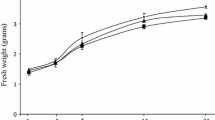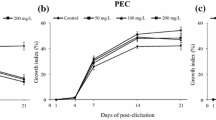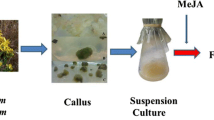Abstract
Hypericum perforatum cell suspensions were evaluated for their growth, phenylpropanoid and naphtodianthrone productions, and antioxidant activity after treatments with fungal elicitors Fusarium oxysporum, Phoma exigua and Botrytis cinerea. Elicited cells displayed a reduced biomass production, a rapid stimulation of secondary metabolites production and a modification of cell redox state compared to control. Cells responded strongly towards the applied elicitors through the enhanced production of naphtodianthrones. Hypericin and pseudohypericin production was significantly increased (up to fourfold) in the early growth phase and remained stable all along the post-elicitation period. Significant increase in contents of total phenolics, total flavonoids and total anthocyanins was observed during the entire period of cultivation, while total flavanols were enhanced at the end of post-elicitation. The enzymatic activities of phenylalanine ammonia lyase and chalcone isomerase were remarkably elevated in elicited cells confirming a strong activation of phenylpropanoid/flavonoid pathways. The fingerprint profile of Fourier transform infrared spectroscopy spectra from the cell walls showed a little variation in lignin accumulation between elicited and control samples. With regards to the antioxidant state, an early up-regulation of peroxidase activity was observed in elicited cells, whereas non-enzymatic properties and catalase activity were enhanced at the end of post-elicitation. These findings suggest the involvement of an efficient antioxidant defense system in the adaptive response of cells to fungal elicitation. Altogether, these results indicated that H. perforatum elicited cells represent a promising experimental system for scale-up production of naphtodianthrones for medicinal uses.




Similar content being viewed by others
Abbreviations
- CAT:
-
Catalase
- CHI:
-
Chalcone isomerase
- FTIR:
-
Fourier transform infrared spectroscopy
- HYP:
-
Hypericin
- JA:
-
Jasmonic acid
- NEAOP:
-
Non-enzymatic antioxidant properties
- PAL:
-
Phenylalanine ammonia lyase
- PHYP:
-
Pseudohypericin
- POD:
-
Peroxidase
- ROS:
-
Reactive oxygen species
- SA:
-
Salicylic acid
- TA:
-
Total anthocyanins
- TFL:
-
Total flavanols
- TF:
-
Total flavonoids
- TP:
-
Total phenolics
References
Alonso-Simon A, Garcia-Angulo A, Acebes JL (2004) FTIR spectroscopy monitoring of cell wall modifications during the habituation of bean (Phaseolus vulgaris L.) callus cultures to dichlobenil. Plant Sci 167:1273–1281
Bais HP, Vepachedu R, Lawrence CB, Stermitz FR, Vivanco JM (2003) Molecular and biochemical characterization of an enzyme responsible for the formation of hypericin in St. John’s wort (Hypericum perforatum L.). J Biol Chem 34:32413–32422
Berrocal-Lobo M, Molina A (2008) Arabidopsis defense response against Fusarium oxysporum. Trends Plant Sci 13:145–150
Boerema GH, de Gruyter J, Noordeloos ME, Hamers MEC (2004) Phoma identification manual. Differentiation of specific and intra-specific taxa in culture. CABI Publishing, Wallingford
Bradford MM (1976) A rapid and sensitive method for the quantification of microgram quantities of protein utilizing the principle of protein-dye binding. Anal Biochem 72:248–254
Cirak C, Aksoy HM, Ayan AK, Saglam B, Kevseroglu K (2005) Enhanced hypericin production in Hypericum perforatum and Hypericum pruinatum in response to inoculation with two fungal pathogens. Plant Prot Sci 4:109–114
Conforti F, Statti GA, Tundis R, Menichini F, Houghton P (2002) Antioxidant activity of methanolic extract of Hypericum triquetrifolium Turra aerial part. Fitoterapia 6:479–483
de Ascensao AR, Dubery IA (2003) Soluble and wall-bound phenolics and phenolic polymers in Musa acuminata roots exposed to elicitors from Fusarium oxysporum f.sp. cubense. Phytochemistry 63:679–686
Dixon RA, Achnine L, Kota P, Liu CJ, Reddy MKS, Wang L (2002) The phenylpropanoid pathway and plant defence-a genomics perspective. Mol Plant Pathol 3:371–390
Faix O (1991) Classification of lignins from different botanical origins by FT-IR spectroscopy. Holzforschung 45:21–27
Fofana B, McNally DJ, Labbé C, Boulanger R, Benhamou N, Séguin A, Bélanger RR (2002) Milsana-induced resistance in powdery mildew-infected cucumber plants correlates with the induction of chalcone synthase and chalcone isomerase. PMPP 61:121–132
Fu J, Huang B (2001) Involvement of antioxidants and lipid peroxidation in the adaptation of two cool-season grasses to localized drought stress. Environ Exp Bot 45:105–114
Gadzovska Simic S, Tusevski O, Maury S, Delaunay A, Joseph C, Hagège D (2014) Effects of polysaccharide elicitors on secondary metabolite production and antioxidant response in Hypericum perforatum L. shoot cultures. Sci World J. doi:10.1155/2014/609649
Gadzovska S, Maury S, Ounnar S, Righezza M, Kascakova S, Refregiers M, Spasenoski M, Joseph C, Hagège D (2005) Identification and quantification of hypericin and pseudohypericin in different Hypericum perforatum L. in vitro cultures. Plant Physiol Biochem 43:591–601
Gadzovska S, Maury S, Delaunay A, Spasenoski M, Joseph C, Hagege D (2007) Jasmonic acid elicitation of Hypericum perforatum L. cell suspensions and effects on the production of phenylpropanoids and naphtodianthrones. Plant Cell Tiss Org 89:1–13
Gadzovska S, Maury S, Delaunay A, Spasenoski M, Hagège D, Courtois D, Joseph C (2013) The influence of salicylic acid elicitation of shoots, callus, and cell suspension cultures on production of naphtodianthrones and phenylpropanoids in Hypericum perforatum L. Plant Cell Tiss Org 113:25–39
Gadzovska-Simic S, Tusevski O, Antevski S, Atanasova-Pancevska N, Petreska J, Stefova M, Kungulovski D, Spasenoski M (2012) Secondary metabolite production in Hypericum perforatum L. cell suspensions upon elicitation with fungal mycelia from Aspergillus flavus. Arch Biol Sci 64:113–121
Gamborg OL, Miller RA, Ojima K (1968) Nutrient requirements of suspension cultures soybean root cells. Exp Cell Res 50:148–151
Gill SS, Tuteja N (2010) Reactive oxygen species and antioxidant machinery in abiotic stress tolerance in crop plants. Plant Physiol Biochem 48:909–930
Giusti MM, Rodriguez-Saona LE, Wrolstad RE (1999) Spectral characteristics, molar absorptivity and color of pelargonidin derivates. J Agric Food Chem 47:4631–4637
Glazebrook J (2005) Contrasting mechanisms of defense against biotrophic and necrotrophic pathogens. Annu Rev Phytopathol 43:205–227
Gonzales LF, Rojas CM, Perez JF (1999) Diferulate and lignin formation is related to biochemical differences of wall-bound peroxidases. Phytochemistry 50:711–717
Hano C, Addi M, Bensaddek L, Cronier D, Baltora-Rosset S, Doussot J, Maury S, Mesnard F, Chabbert B, Hawkins S, Lainé E, Lamblin F (2006) Differential accumulation of monolignol-derived compounds in elicited flax (Linum usitatissimum) cell suspension cultures. Planta 223:975–989
Karppinen K, Hohtola A (2008) Molecular cloning and tissue-specific expression of two cDNAs encoding polyketide synthases from Hypericum perforatum. J Plant Physiol 165:1079–1086
Karuppusamy S (2009) A review on trends in production of secondary metabolites from higher plants by in vitro tissue, organ and cell cultures. J Med Plants Res 3:1222–1239
Kirakosyan A, Hayashi H, Inoue K, Charchoglyan A, Vardapetyan H (2000) Stimulation of the production of hypericins by mannan in Hypericum perforatum shoot cultures. Phytochemistry 53:345–348
Kirakosyan A, Sirvent TM, Gibson DM, Kaufman PB (2004) The production of hypericins and hyperforin by in vitro cultures of St. John’s wort (Hypericum perforatum). Biotechnol Appl Biochem 39:71–81
Košuth J, Koperdáková J, Tolonen A, Hohtola A, Cellárová E (2003) The content of hypericins and phloroglucinols in Hypericum perforatum L. seedlings at early stage of development. Plant Sci 165:515–521
Kulisic T, Radonic A, Katalinic V, Milos M (2004) Use of different methods for testing antioxidative activity of oregano essential oil. Food Chem 85:633–640
Laroche C, Gervais P (2003) Achievement of rapid osmotic dehydration at specific temperatures could maintain high Saccharomyces cerevisiae viability. Appl Microbiol Biotechnol 60:743–747
Lattanzio V, Lattanzio VM, Cardinali A (2006) Role of phenolics in the resistance mechanisms of plants against fungal pathogens and insects. Phytochem Adv Res 661:23–67
Leonard KJ, Bushnell WR (2004) Fusarium Head Blight of Wheat and Barley. APS Press, USA
Li YG, Tanner G, Larkin P (1996) The DMACA-HCl protocol and the threshold proanthocyanidin content for bloat safety in forage legumes. J Sci Food Agr 70:89–101
Li P, Luo H, Meng J et al (2014) Effects of oligosaccharides from endophytic Fusarium oxysporum Dzf17 on activities of defense-related enzymes in Dioscorea zingiberensis suspension cell and seedling cultures. Electron J Biotechn 17:156–161
Makris DP, Boskou G, Andrikopoulos NK (2007) Polyphenolic content and in vitro antioxidant characteristics of wine industry and other agri-food solid waste extracts. J Food Comp Anal 20:125–132
Marron N, Delay D, Petit JM, Dreyer E, Kahlem G, Delmotte FM, Brignolas F (2002) Physiological traits of two Populus × euramericana clones, Luisa Avanzo and Dorskamp, during a water stress and re-watering cycle. Tree Physiol 22:49–858
Meirelles G, Pinhatti AV, Sosa-Gomez D, Rosa LMG, Rech SB, von Poser GL (2013) Influence of fungal elicitation with Nomuraea rileyi (Farlow) Samson in the metabolism of acclimatized plants of Hypericum polyanthemum Klotzsech ex Reichardt (Guttiferae). Plant Cell Tiss Org 112:379–385
Morel G, Wetmore RH (1951) Tissue culture of monocotyledons. Am J Bot 38:138–140
Murashige T, Skoog F (1962) A revised medium for rapid growth and bioassays with tobacco tissue cultures. Physiol Plant 15:473–497
Murch SJ, Saxena PK (2006) St. John’s wort (Hypericum perforatum L.): challenges and strategies for production of chemically consistent plants. Can J Plant Sci 86:765–771
Murthy HN, Lee EJ, Paek KY (2014) Production of secondary metabolites from cell and organ cultures: strategies and approaches for biomass improvement and metabolite accumulation. Plant Cell Tiss Org 118:1–16
Nahrstedt A, Butterweck V (2010) Lessons learned from herbal medicinal products: the example of St. John’s wort. J Nat Prod 73:1015–1021
Namdeo AG (2007) Plant cell elicitation for production of secondary metabolites: a review. Pharmacogn Rev 1:69–79
Nita-Lazar M, Heyraud A, Gey C, Braccini I, Lienart Y (2004) Novel oligosaccharides isolated from Fusarium oxysporum L. rapidly induce PAL activity in Rubus cells. Acta Biochim Pol 51:625–634
Nowogórska A, Patykowski J (2015) Selected reactive oxygen species and antioxidant enzymes in common bean after Pseudomonas syringae pv. phaseolicola and Botrytis cinerea infection. Acta Physiol Plant 37:1–10
Pandey KK, Pitman AJ (2003) FTIR studies of the changes in wood chemistry following decay by brown-rot and white-rot fungi. Inter Biodeter Biodegr 52:151–160
Pillai PP, Nair AR (2014) Hypericin biosynthesis in Hypericum hookerianum Wight and Arn: Investigation on biochemical pathways using metabolite inhibitors and suppression subtractive hybridization. Comptes Rendus Biol 337:571–580
Polkowska-Kowalczyk L, Wielgat B, Maciejewska U (2007) Changes in the antioxidant status in leaves of Solanum species in response to elicitor from Phytophthora infestans. J Plant Physiol 164:1268–1277
Silva BA, Ferreres F, Malva JO, Dias ACP (2005) Phytochemical and antioxidant characterization of Hypericum perforatum alcoholic extracts. Food Chem 90:157–167
Singleton VL, Rossi JA (1965) Colorimetry of total phenolics with phosphomolybdic-phosphotungstic acid reagents. Am J Enol Vitic 16:144–158
Sirvent T, Gibson D (2002) Induction of hypericins and hyperforin in Hypericum perforatum L. in response to biotic and chemical elicitors. Physiol Mol Plant Pathol 60:311–320
Sivakumar G, Paek KY (2005) Methyl jasmonate induce enhanced production of soluble biophenols in Panax ginseng adventitious roots from commercial scale bioreactors. Chem Nat Compd 41:669–673
Solomon D, Adams J, Graves N (2013) Economic evaluation of St. John’s wort (Hypericum perforatum) for the treatment of mild to moderate depression. J Affect Disord 148:228–234
Stewart D, Lyon GD, Tucker EJB (1994) A Fourier-transform infrared spectro6scopic and microscopic study of the infection of potato tubers by Erwinia carotovora ssp. carotovora in aerobic and anaerobic conditions. J Sci Food Agric 66:145–154
Tusevski O, Petreska Stanoeva J, Stefova M, Gadzovska Simic S (2014) Agrobacterium enhances xanthone production in Hypericum perforatum cell suspensions. Plant Growth Regul. doi:10.1007/s10725-014-9989-6
Ververidis F, Trantas E, Douglas C, Vollmer G, Kretzschmar G, Panopoulos N (2007) Biotechnology of flavonoids and other phenylpropanoid-derived natural products. Part I: chemical diversity, impacts on plant biology and human health. Biotechnol J 2:1214–1234
Walker ST, Pal Bais H, Vivanco MJ (2002) Jasmonic acid-induced hypericin production in cell suspension cultures of Hypericum perforatum L (St. John’s wort). Phytochemistry 60:289–293
Xu MJ, Dong JF, Zhu MY (2005) Nitric oxide mediates the fungal elicitor-induced hypericin production of Hypericum perforatum cell suspension cultures through a jasmonic-acid-dependent signal pathway. Plant Physiol 139:991–998
Xu M, Sheng J, Wang H, Dong J (2011) Involvement of NADPH oxidase-mediated H2O2 signaling in PB90-induced hypericin accumulation in Hypericum perforatum cells. Plant Cell Tiss Org 105:47–53
Yuan YJ, Li JC, Hu ZD, Wu JC, Zeng AP (2002) Fungal elicitor-induced cell apoptosis in suspension cultures of Taxus chinensis var. mairei for taxol production. Proc Biochem 38:193–198
Yue W, Ming QL, Lin B, Rahman K, Zheng CJ, Han T, Qin LP (2014) Medicinal plant cell suspension cultures: pharmaceutical applications and high-yielding strategies for the desired secondary metabolites. Crit Rev Biotechnol 0:1–18
Zhao J, Davis L, Verpoorte R (2005) Elicitor signal transduction leading to production of plant secondary metabolites. Biotechnol Adv 23:283–333
Acknowledgments
This work and a Ph.D. grant (Sonja Gadzovska) was supported by the Ministère des Affaires Etrangères (Programme COCOP: Réseau d’Enseignement régional Postgraduate en Biologie, Grant No. DSUR-NGE-4B1-505). We thank Dr S. Ounnnar, S. Pochon, G. Moreau for their technical help. We acknowledge Dr F. Brignolas for his help in statistical analyses.
Author information
Authors and Affiliations
Corresponding author
Rights and permissions
About this article
Cite this article
Gadzovska Simic, S., Tusevski, O., Maury, S. et al. Fungal elicitor-mediated enhancement in phenylpropanoid and naphtodianthrone contents of Hypericum perforatum L. cell cultures. Plant Cell Tiss Organ Cult 122, 213–226 (2015). https://doi.org/10.1007/s11240-015-0762-y
Received:
Accepted:
Published:
Issue Date:
DOI: https://doi.org/10.1007/s11240-015-0762-y




